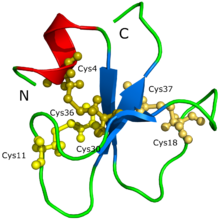- Crotamine
-
Crotamine is a toxin present in the venom of the South American rattlesnake (Crotalus durissus terrificus). It was first isolated and purified by Brazilian scientist José Moura Gonçalves, and later intensively studied by his group of collaborators at the Medical School of Ribeirão Preto of the University of São Paulo (C.R. Laure, A. Haddad, F.L. De Lucca and J.R. Giglio, among others). It is a 42-long polypeptide containing 11 basic residues (9 lysines, 2 arginines) and 6 cysteines. It has also been isolated from the venom of North American prairie rattlesnake, Crotalus viridis viridis.
Crotamine has a number of biological actions: it acts on cell membrane's sodium channels, is slightly analgesic and is myotoxic, i.e., it penetrates the cells of muscles and promotes necrosis. Crotamine is homologous with other venom myotoxins and is similar to α-,β-defensins.
The aminoacid sequence and the 3D molecular structure of crotamine have already been determined.
YKQCHKKGGHCFPKEKICLPPSSDFGKMDCRWRWKCCKKGS—G
The gene and chromosome location responsible for its synthesis have been identified by the group led by Gandhi Rádis-Baptista, working at the Instituto Butantan, in São Paulo, Brazil. The mRNA has about 340 nucleotides and codifies a pre-crotamine, including the signal peptide, the mature crotamine, and a final lysine.
References
- Gonçalves JM, Deutsch HF. Ultracentrifugal and zone electrophoresis studies of some crotalidae venoms. Arch Biochem Biophys. 1956 Feb;60(2):402-11. doi:10.1016/0003-9861(56)90444-1 PMID 13292919
- Giglio JR. Analytical studies on crotamine hydrochloride. Anal Biochem. 1975 Nov;69(1):207-21. PMID 2030
- Laure CJ. The primary structure of crotamine. Hoppe Seylers Z Physiol Chem. 1975 Feb;356(2):213-5. German. PMID 1176086
- De Lucca FL, Imaizumi MT, Haddad A. Characterization of ribonucleic acids from the venom glands of Crotalus durissus terrifucus (Ophidia, Reptilia) after manual extraction of the venom. Studies on template activity and base composition. Biochem J. 1974 Apr;139(1):151-6. PMID 4463939
- Ownby, C. L., Cameron, M. S., and Tu, A. T. (1976) Isolation of myotoxin component from rattlesnake (Crotalus viridis viridis) venom. Am. J. Pathol. 85, 149–166
- Rádis-Baptista, G., Oguiura, N., Hayashi, M. A. F., Camargo, M. E., Grego, K. F., Oliveira, E. B., and Yamane, T. (1999) Nucleotide sequence of crotamine isoform precursors from a single South American rattlesnake (Crotalus durissus terrificus). Toxicon 37, 973–984
- Alexandre Kerkis, Irina Kerkis, Gandhi Rádis-Baptista, Eduardo B. Oliveira, Angela M. Vianna-Morgante, Lygia V. Pereira, and Tetsuo Yamane. Crotamine is a novel cell-penetrating protein from the venom of rattlesnake Crotalus durissus terrificus. The FASEB Journal Express Article doi:10.1096/fj.03-1459fje. Published online July 1, 2004
- Radis-Baptista G, Kubo T, Oguiura N, Prieto da Silva AR, Hayashi MA, Oliveira EB, Yamane T. Identification of crotasin, a crotamine-related gene of Crotalus durissus terrificus. Toxicon. 2004 Jun 1;43(7):751-9. PMID 15284009
- Radis-Baptista G, Kubo T, Oguiura N, Svartman M, Almeida TM, Batistic RF, Oliveira EB, Vianna-Morgante AM, Yamane T. Structure and chromosomal localization of the gene for crotamine, a toxin from the South American rattlesnake, Crotalus durissus terrificus. Toxicon. 2003 Dec;42(7):747-52. PMID 14757205
- Nicastro G, Franzoni L, de Chiara C, Mancin AC, Giglio JR, Spisni A. Solution structure of crotamine, a Na+ channel affecting toxin from Crotalus durissus terrificus venom. Eur J Biochem. 2003 May;270(9):1969-79. PMID 12709056
- Mouhat S, Jouirou B, Mosbah A, De Waard M, Sabatier JM. Diversity of folds in animal toxins acting on ion channels. Biochem J. 2004 Mar 15;378(Pt 3):717-26. PMID 14674883
External links
- Nucleotide sequence and translation for crotasin. Entrez Database. National Center for Biotechnology Information.
Categories: Peptides | Vertebrate toxins
Wikimedia Foundation. 2010.

